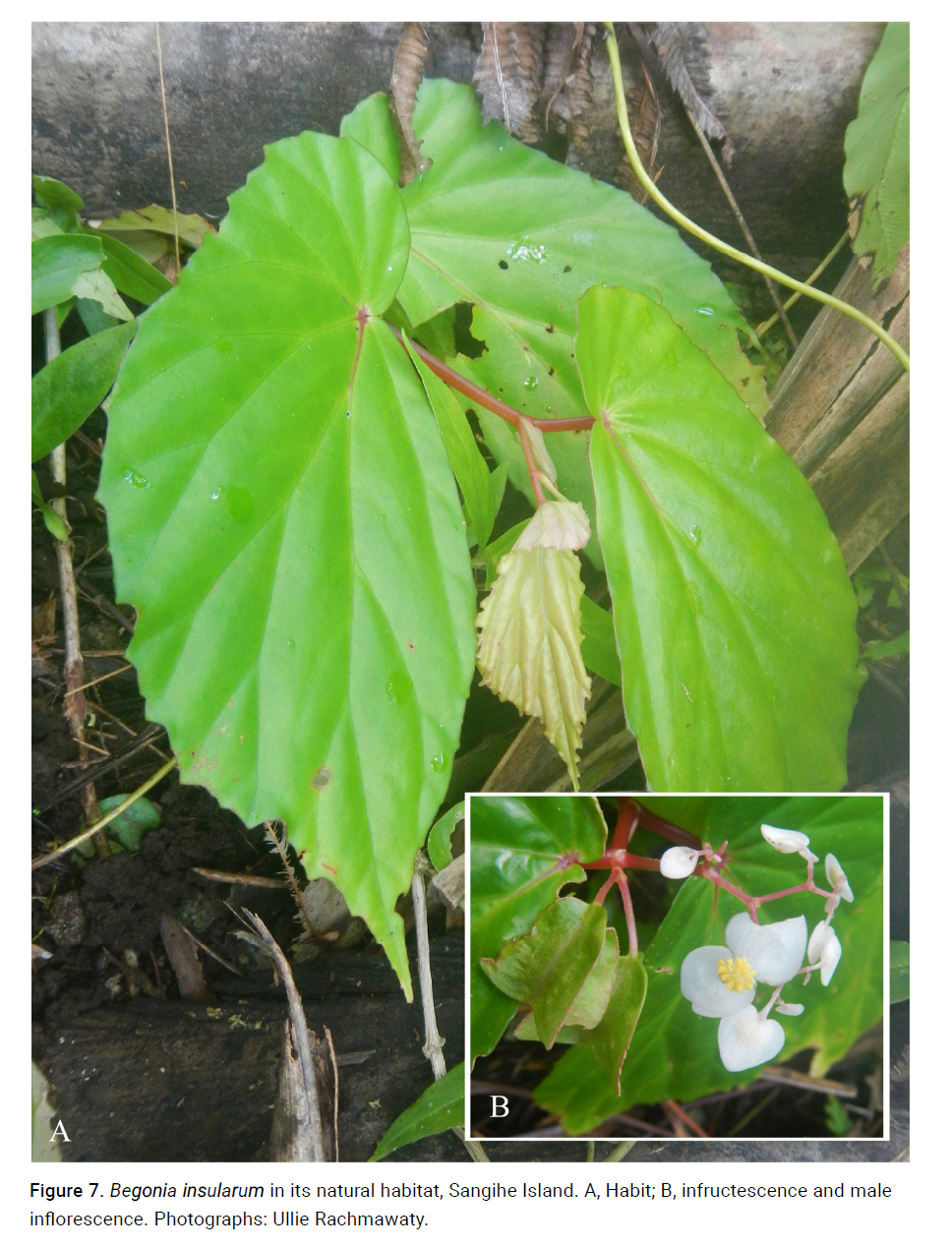Begonia insularum in Bot. Jahrb. Syst. 50(4): 353. 1913
Primary tabs

Habitat & Ecology
- Transition of upland to hill rain forest with palms or secondary forest at 800 m elevation. (Ardi, W.H. & Thomas, D.C. 2022: Synopsis of Begonia (Begoniaceae) from the northern arm of Sulawesi and Sangihe Island, Indonesia, including three new species. – Edinburgh J. Bot. 79(Begonia special issue, article 405): 1-50. http://doi.org/10.24823/EJB.2022.405)
Conservation
- Proposed IUCN category: DD. The locality on Sangir Island is not defined in the protologue, nor is there sufficient information available on the state of forest cover on the island. (Hughes, M. An annotated checklist of Southeast Asian Begonia. 2008)
- Vulnerable (VUD2). This species is known from only two collections, both of which have no exact locality information. Despite the legal protection of some areas on Sangihe (Sangir) Island due to being part of Sanger Gunung Api Uwu National Park, there are clear signs of anthropogenic disturbance, including habitation and nutmeg plantations, around the island. All available Begonia specimens from A, B, BM, BO, CEB, E, K, L and SING have been consulted, and therefore it must be assumed, at least until more intensive collecting on Sulawesi may reveal otherwise, that this species has a very restricted range. Therefore, this species is probably ‘prone to the effects of human activities or stochastic events within a very short time period in an uncertain future’ (IUCN Standards and Petitions Subcommittee, 2019). (Ardi, W.H. & Thomas, D.C. 2022: Synopsis of Begonia (Begoniaceae) from the northern arm of Sulawesi and Sangihe Island, Indonesia, including three new species. – Edinburgh J. Bot. 79(Begonia special issue, article 405): 1-50. http://doi.org/10.24823/EJB.2022.405)
Distribution
Indonesia: endemic to Sulawesi, Sangihe (Sangir) Island. (Ardi, W.H. & Thomas, D.C. 2022: Synopsis of Begonia (Begoniaceae) from the northern arm of Sulawesi and Sangihe Island, Indonesia, including three new species. – Edinburgh J. Bot. 79(Begonia special issue, article 405): 1-50. http://doi.org/10.24823/EJB.2022.405)
Notes
- Begonia insularum is endemic to Sangihe (Sangir) Island. It is one of the most poorly known species in Sulawesi, being known from only a few specimen records and observations. Recently, the species was documented during a field survey by a colleague from Bogor Botanic Gardens (Ully Rachmawaty); however, no herbarium vouchers were made. Begonia insularum is similar to B. isoptera Dryand. ex Sm. from western Malesia (Java and Sumatra), but B. insularum can be distinguished from that species by several characters, including fewer stamens (25 vs 40 stamens), 5-tepalled female flowers (vs 3-tepalled female flowers) and fruit wings with a rounded base and truncate apex (vs fruit wings with cuneate base and truncate apex). (Ardi, W.H. & Thomas, D.C. 2022: Synopsis of Begonia (Begoniaceae) from the northern arm of Sulawesi and Sangihe Island, Indonesia, including three new species. – Edinburgh J. Bot. 79(Begonia special issue, article 405): 1-50. http://doi.org/10.24823/EJB.2022.405)
Specimens
- Indonesia. Sulawesi. Sangihe Talaud Islands: Sangihe Island, 5 xi 1998, D.Hicks & Anius 135 (K). (Ardi, W.H. & Thomas, D.C. 2022: Synopsis of Begonia (Begoniaceae) from the northern arm of Sulawesi and Sangihe Island, Indonesia, including three new species. – Edinburgh J. Bot. 79(Begonia special issue, article 405): 1-50. http://doi.org/10.24823/EJB.2022.405)

